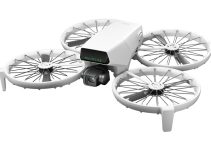Even though 3-axis gimbal stabilizers are ubiquitous these days, the ability to shoot professional handheld videos remains a viable skill for every self-respecting cinematographer. Handheld style of shooting can not only create unique visual aesthetics but if done the right way it can bring your scenes to life without requiring any time-consuming setups or expensive equipment.
Whether you choose to shoot handheld for personal convenience, or simply want to add a bit different vibe and energy to your footage, here are a bunch of advanced tips and tricks that might help you to pull off these type of shots quickly and efficiently.
It wouldn’t be an overstatement to say that by holding and moving your camera in a particular manner you can replicate in a way shots achieved with much more complex gear such as cranes, dollies, or any other mechanical tools. Whatever sort of compact camera you tend to shoot with, though, don’t hold it at the sides, but make sure you get one hand under the lens. That way, you’ll be able to balance the unit more properly and also help you to focus more precisely. To simulate a dolly move, for instance, you don’t even have to move forwards. You can just move the camera away from your body as steadily as possible.
As-a-rule-of-thumb, don’t try to add a handheld look to your footage. Just use these techniques to emulate a certain sliding effect without having to set up an additional gear. For longer handheld moves, however, you will need to take some steps forward as the secret for getting this right is to move your camera away from your body first and then begin walking. By combining these two motions, you can make the move look considerably smoother. Of course, it’s impossible to eliminate the handheld jittery feel of the camera movement completely, but with patience and practice, you can achieve some decent results.
Furthermore, panning and tilting the camera while using similar technique can also be as simple and straightforward as using a tripod. Additionally, you can hold the camera still and arc your body around. This will give you a slightly wider pan, and it won’t feel as mechanical as a standard tripod pan. You can also try to push the camera away from your body while panning and arcing even more to get the feel of a crane shot rather than a pan movement. When combining this technique with slight up and down movements, eventually you can create even more complex and appealing shots.
Moreover, for changes of height, you don’t even have to move your legs at all. If you start low, you can simply raise the camera up in your hands. However, if you want to get even higher, again the trick is to move with your hands first and then move your legs, so you begin with raising your hands and then stand up slowly while covering the distance with your body movement. You can also try combining as many motions as you want as long as you don’t make any jittery moves along the line that might ruin the shot.
Ultimately, the handheld work has the potential to combine multiple mechanical moves to create really complex and appealing sequences that can immerse your audience deeper into the story as it unfolds.
[source: Tuts+ Photo & Video]
Disclaimer: As an Amazon Associate partner and participant in B&H and Adorama Affiliate programmes, we earn a small comission from each purchase made through the affiliate links listed above at no additional cost to you.





The proper way of shooting high quality videos is using a stabilizer (any kind, even a monopod). 🙂
I can’t agree with you, Eno. Every project requires certain style of shooting. If handheld is the most suitable approach, I don’t see a reason why not to shoot this way. The execution itself along with the skill set of the cinematographer is a whole different story, though.
I perfectly understand your point, but I just hate hand held shot films! :))
So because you hate handheld-shot films that means handheld shooting is used by amateurs?
Also, aren’t your hands technically stabilizers?
Any good commercial video productions isn’t shot hand held. 🙂
If you say so! ¯_(ツ)_/¯